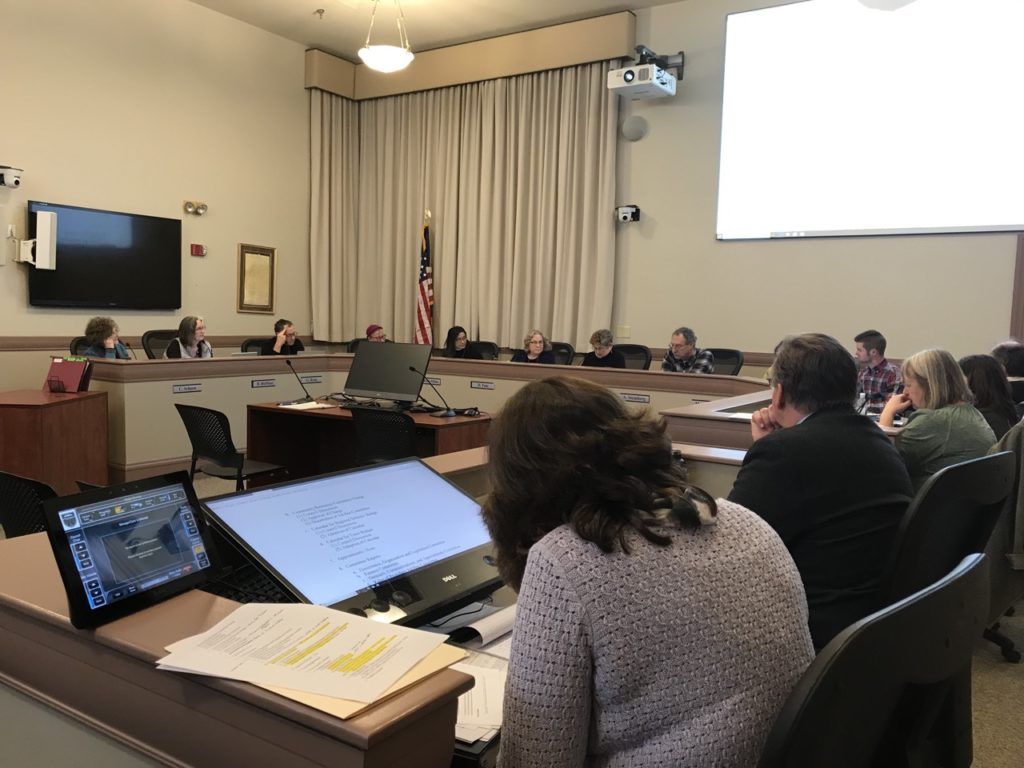Opinion: The Council at One Year – A LOT OF WORK BUT NOT MUCH TO SHOW FOR IT

Amherst Town Council Meeting, Town Room, Town Hall, Amherst. Photo: Maura Keene

Over the past year, I have attended most of the Town Council meetings. Out of these more than one hundred hours, I have observed the good, the bad and the ugly in our new government. I have watched our Town Councilors put in staggering amounts of time only to get bogged down in adminstriva or small disagreements or in the inability to clearly set goals or efficiently conclude a debate. Here are some of the things that I found most frustrating in this first year of new government.
Length of Meetings
One problem faced by the Council is the length of its meetings. Northampton’s City Council meets four times/month with meetings usually taking a couple of hours. Amherst Town Council meetings rarely end before 11 p.m. (4.5 hours) and often go until midnight. Even so, items at the end of the Amherst Council’s agenda such as the Town Manager’s report and committee reports, are often given short shrift. This could simply be due to the fact that Amherst has 13 councilors. It often seems that Amherst’s councilors feel the need to weigh in on discussions even if they have no new insights or information to contribute and discussions are frequently repetitive and meandering. It is well known that as meetings drag on efficacy and attention decease and this seems to be the case with our own council meetings.
Council President Lynn Griesemer has tried to create a balance between public participation and efficiency by allowing anyone who desires to address the Council to do so but by imposing a three minute time limit on each comment. Griesemer has encouraged those commenting to not repeat points already raised. But in the face of fervent supporters of an issue, Greisemer has relaxed enforcement of the time limit. For example, opponents to the studio apartments on Northampton Road were allowed to hijack a public forum on the budget. And then despite being allocated a four hour special council meeting devoted to this topic, they returned to Council sessions on multiple occasions to make the same points over and over again.
The inefficiencies of public comment are hardly the primary source of the Council’s ineffectiveness, and I am not suggesting that the Council curtail public comment. Indeed, in a body that has shown ambivalence about engaging the public and taking residents’ input seriously, more opportunities for receiving and digesting public comments are needed.
One suggestion offered in the early months of the Council (but not formally proposed) is that the Council could accept formal, written comments from the public and enter them into the official record of each meeting along with the minutes as if they had been delivered as public comment. This would free commenters from the three-minute limit which is now differentially enforced. It would create an opportunity for people who are uncomfortable with public speaking to participate. And it might free up a few minutes now and then from the typically overpacked Council agenda.
Process and Procedure
Another factor in the length of Council meetings is the time spent on process and procedures, rather than issues. This is to be expected to a degree with a new government that must develop rules of procedure from scratch and deal with various situations not explicitly addressed by a new charter. Our Councilors are, in effect, trying to govern at the same time that they are trying to establish the government. “Building the plane while trying to fly it” is a phrase that has been used repeatedly as an explanation for evident inefficiencies.
Nonetheless, the time spent on minutiae and administrivia seems excessive. The Outreach, Communication, and Appointments Committee (OCA) spent most of the year trying to establish a fair and open means of appointing citizens to town committees, while maintaining the privacy of those applying by shielding their names and the numbers who have applied from the public. It is hard to overstate the gymnastics the committee has gone through to attain these contradictory goals, and the matter of appointments is not yet settled. Meanwhile, most town committees are appointed by the Town Manager and in the opinion of the Town Manager are outside the purview of OCA. For all the debate, the process of Town Manager appointments remains unchanged and mostly opaque.
Checks and Balances
A perhaps unintended consequence of the Charter is the concentration of power in the Town Manager. Previously, the five-person Select Board served as the executive branch and Town Meeting as the legislative branch, but now the Town Manager is the sole executive, and is appointed and evaluated by the Council. He is not elected. The Council President works closely with the Town Manager to determine town priorities and plans for addressing them, but the Council does not seem to exercise oversight of the Manager and is in fact dependent on him for the conduct of its own business and the information that the councilors need. There appears to be little visible friction between the executive and legislative branches of government aside from a small dust up between OCA and the Town Manager over how much information the Town Manager is required to share with the Council about candidates for appointment to town committees. While the Town Manager received an excellent annual review from the Council President, it remains to be seen whether he works for the Council or vice versa, and whether the fear that the Charter might eliminate checks and balances in government will prove to be justified.
Much Work, Few Accomplishments
There is no question that our Councilors worked very hard this year but that work produced few substantial accomplishments. With scant discussion, the Council approved about $250,000 for a temporary bridge on Station Road. Borrowing for the controversial studio apartment complex on Northampton Road was approved. The sustainability goal to reduce carbon emissions to zero by 2050 was unanimously approved, but it is unclear whether the Council will allocate the additional resources and support the legislation needed to achieve this goal. The Council held a number of well attended public forums but has yet to make clear how they will incorporate public input meaningfully into their own deliberations. And the Council passed a budget albeit with little input from the public. But most of the actual work of the Council focused on process, certainly a necessary component of governing, but perhaps overwhelming more important and more pressing work.
Looking Ahead
So it was a mixed and sometimes frustrating year in town government. I believe that the Councilors are trying to act with the best interests of the town at heart. Next year, the town will have some big decisions to make – about spending and borrowing, about configuring the schools and about sustainability to name a few. The Council will need to approach these decisions with greater efficacy than they have demonstrated in their inaugural year and with an effort to build consensuses that transcend the remnants of polarization in town. How these issues and the controversies they engender are handled will say a lot about how well our new government is serving the town.

In the first paragraph about the length of Council meetings, Maura’s observations mirror almost exactly those made by critics of Town Meeting: Endless meetings that dragged on and on, with people who felt the need to grandstand simply for the sake of grandstanding, and a lack of efficiency and effectiveness. This was all supposed to be left behind in the past, and we were to move forward into a bright future of executive efficiency and Getting Things Done.
Part of the problem lies in the fact that governing, when it is not done through a dictatorship, is always slower and messier than one might imagine or hope. Taking into account multiple and often conflicting perspectives and attempting to reconcile them into actions that will be in the best interests of the town as a whole is a much more difficult undertaking when you are the individual or individuals who are doing it, rather than when you are sitting on the outside observing those who are doing so.
I was a member of Town Meeting for nearly 20 years. Certainly there were times when I was frustrated by how much time it took and how things turned out. But it was by no means a loss: Yes, I had to put a lot of time, energy, and emotion into Town Meeting, but the return on my investment was the opportunity to participate firsthand in the governance of my town, to have my say in the process, to hear what my fellow residents had to say, and to learn from them. Priceless? Some might argue to the contrary, but I would say that it was well worth it.
Rather than concentration of executive power, the problem may instead be the concentration of executive responsibility: it’s simply too much for one person – even a very capable person – to thoughtfully manage something as complex as Amherst.
One might argue that the manager could share this responsibility with department heads or assistant managers. But it’s not enough to get feedback only from heads and assistants, who serve under the manager’s authority.
Thoughtful management needs regular feedback from the public, through an elected supervisory body, such as the former Select Board was intended to provide, to help the manager make well-informed decisions.
Perhaps a Charter amendment…?